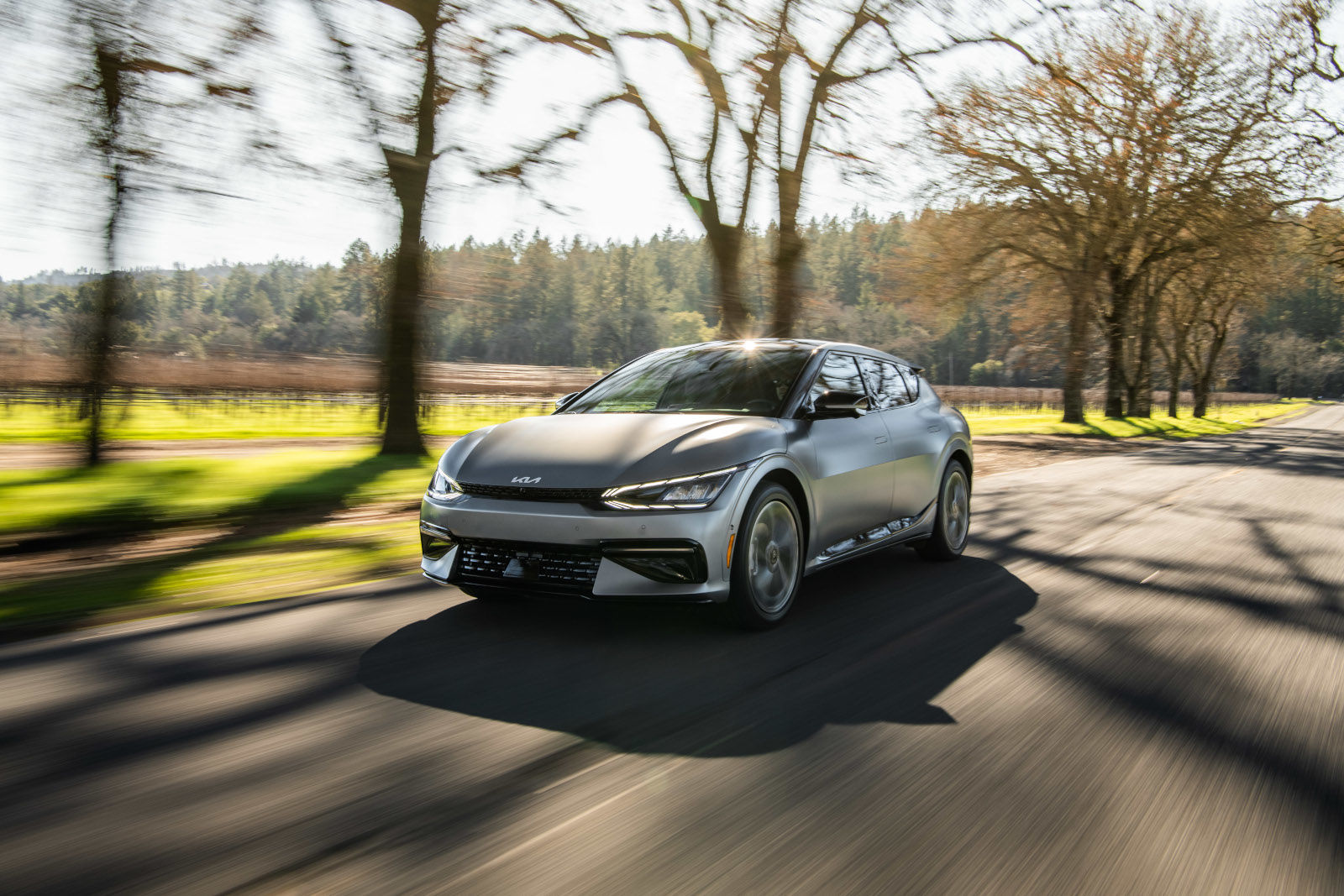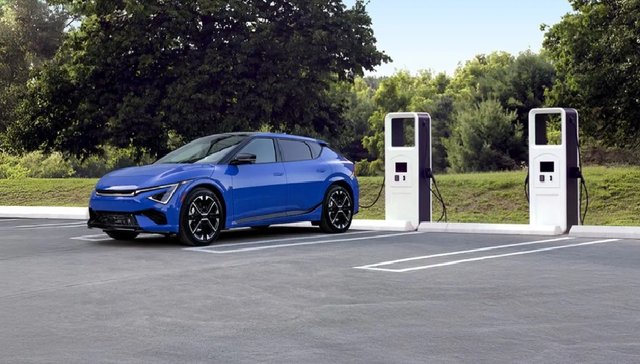With the growing variety of electrified vehicles available, Kia offers an impressive lineup of electric vehicles (EVs), plug-in hybrids (PHEVs), and hybrid vehicles (HEVs) in 2025. To help you navigate these options, we’ve compiled a Q&A guide that answers common questions about each type of vehicle, their performance, efficiency, and which one might be the best fit for your needs.
What makes a fully electric vehicle (EV) different from other vehicles?
A fully electric vehicle (EV), like the 2025 Kia EV6 or Kia EV9, runs entirely on electricity. Unlike traditional vehicles, EVs don’t have a gasoline engine. Instead, they rely on a large battery pack to power an electric motor. This means no emissions from the tailpipe and a quieter, smoother ride. The battery is recharged by plugging the vehicle into an electric power source, whether at home or at a public charging station.
EVs are known for their immediate power delivery, thanks to the electric motor's ability to provide instant torque. This results in quick acceleration, making EVs both responsive and enjoyable to drive. In terms of range, the EV6 can cover up to 500 kilometers on a full charge, while the larger EV9 offers a range of up to 483 kilometers.
How does a Plug-in Hybrid (PHEV) function, and when is it the better choice?
A Plug-in Hybrid (PHEV) combines a gasoline engine with an electric motor, giving you the flexibility to drive on electric power alone for short distances. The battery in a PHEV is larger than in a standard hybrid, which allows for a limited all-electric range—around 42 kilometers in the case of the Kia Niro PHEV. When the battery is depleted, the vehicle seamlessly switches to using the gasoline engine, extending the range indefinitely.
PHEVs are particularly beneficial for drivers who have a short commute or can charge their vehicle regularly, as they allow for emission-free driving on shorter trips. They also provide the reassurance of a gasoline engine for longer journeys, making them a versatile option for a variety of driving needs.
What are the key characteristics of a Hybrid Electric Vehicle (HEV)?
A Hybrid Electric Vehicle (HEV), such as the Kia Sportage HEV or Kia Niro HEV, uses both a gasoline engine and an electric motor to improve fuel efficiency. Unlike PHEVs, hybrids do not need to be plugged in to recharge. Instead, they generate electricity through regenerative braking and by using the gasoline engine.
Hybrids are designed to use the electric motor to assist the gasoline engine, especially during acceleration, which helps to reduce fuel consumption. For example, the Kia Sportage HEV offers a combined fuel economy of about 6.3 L/100 km, making it a great choice for those looking to reduce fuel costs without the need for frequent charging.
How does charging differ between EVs, PHEVs, and HEVs?
Charging requirements vary depending on the type of vehicle. EVs, such as the Kia EV6, must be plugged into an electric outlet or charging station. The charging time can range from several hours with a standard home charger to as little as 18 minutes for a quick top-up using a fast charger.
PHEVs also need to be plugged in to maximize their efficiency. Charging a PHEV, like the Kia Niro PHEV, can be done overnight with a standard outlet or in a few hours using a Level 2 charger. While PHEVs can run on gasoline alone if the battery is depleted, regular charging is recommended to get the most benefit from the electric driving range.
HEVs, on the other hand, do not require external charging. The battery is automatically charged by the vehicle’s gasoline engine and through regenerative braking, which captures energy typically lost during braking.
How do the electric ranges compare among these vehicles?
The electric range is a crucial factor for EVs and PHEVs. For fully electric vehicles, the range is determined by the size of the battery. The 2025 Kia EV6, for instance, can travel up to 500 kilometers on a single charge, making it ideal for those who want to avoid frequent charging stops. The Kia EV9 offers slightly less range, at up to 483 kilometers, but provides more space and versatility.
PHEVs have a much shorter electric range, typically between 40-50 kilometers. The Kia Niro PHEV, for example, can drive up to 42 kilometers purely on electric power before needing to switch to gasoline.
HEVs do not have an all-electric range in the same sense. Instead, they use their electric motor to supplement the gasoline engine, which improves overall fuel efficiency rather than offering standalone electric driving.
What are the top considerations when choosing between these electrified vehicles?
When deciding which type of Kia electrified vehicle best suits your needs, here are 10 key considerations to keep in mind:
- Daily Commute Length: EVs are best for longer commutes if charging infrastructure is readily available, while PHEVs suit shorter daily drives with occasional long-distance travel.
- Availability of Charging Stations: Do you have easy access to charging at home or in public places? EVs and PHEVs benefit from regular charging, while HEVs do not require this.
- Initial Investment: Consider the upfront costs. EVs may have higher purchase prices, but they save on fuel and maintenance over time.
- Environmental Goals: If reducing your carbon footprint is a priority, EVs offer the most environmentally friendly option, producing zero tailpipe emissions.
- Driving Range Anxiety: If you’re worried about running out of battery on long trips, a PHEV or HEV might be more suitable, providing the assurance of a gasoline engine.
- Driving Enjoyment: EVs and PHEVs provide a quiet, smooth ride with quick acceleration. If you value these characteristics, they may be the right choice.
- Towing Requirements: Consider whether you need towing capacity. While some hybrids like the Kia Sorento HEV offer towing capabilities, electric models like the Kia EV9 are also equipped for towing.
- Fuel Savings: How much do you currently spend on fuel? EVs eliminate this cost entirely, while PHEVs and HEVs offer significant savings compared to traditional vehicles.
- Maintenance Costs: EVs typically require less maintenance than gasoline vehicles due to fewer moving parts. PHEVs and HEVs may need more regular upkeep but still offer savings.
- Long-Term Commitment: Think about your long-term plans. EVs are a forward-looking choice as the automotive industry shifts towards electrification, while HEVs and PHEVs provide a balanced transition.
Conclusion
Whether you’re drawn to the zero-emission benefits of an EV, the flexibility of a PHEV, or the fuel-saving advantages of a hybrid, Kia’s 2025 lineup offers a vehicle to match your needs. By understanding the differences in performance, charging, and range, you can make an informed decision that aligns with your lifestyle and driving habits. Each type of electrified vehicle has its own strengths, and with Kia’s diverse options, there’s a model that’s right for you.
To learn more about Kia’s Electric Vehicle lineup, visit Kia.ca







